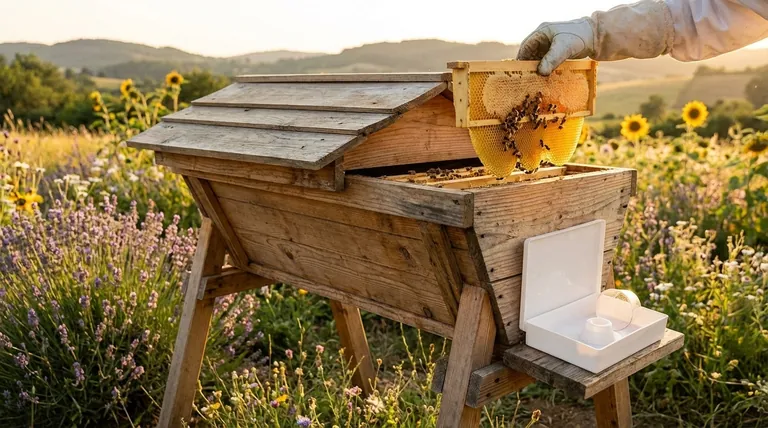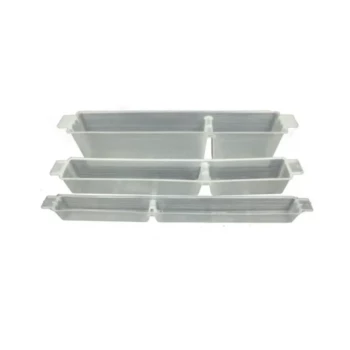At its core, a top-bar hive (TBH) is a single-story, frameless beehive where the bees build their comb naturally, hanging down from individual, removable bars. Unlike the stacked-box design of the more common Langstroth hive, a top-bar hive operates horizontally, functioning as a long, self-contained trough. This design fundamentally changes the way a beekeeper interacts with the colony.
Choosing a hive is not just about housing bees; it's about adopting a management philosophy. The top-bar hive is intentionally simple, prioritizing natural bee behavior and ease of handling over the modularity and high-volume honey production associated with conventional hives.

The Core Anatomy of a Top-Bar Hive
The design of a top-bar hive is straightforward, with each component serving a distinct and intuitive purpose. It is a fully integrated system designed for waist-high management.
The Hive Body: A Horizontal Home
The main structure is a long, horizontal box. The most common style is the Kenyan top-bar hive, which features sloped sides. These angled sides mimic the natural shape of hanging honeycomb and discourage the bees from attaching their comb to the hive walls, making inspections easier. A less common variant, the Tanzanian hive, has straight, vertical sides.
The Top Bars: Foundationless by Design
Instead of frames with pre-installed foundation, the hive uses simple wooden bars that sit flush against each other, forming a solid roof. The bees build their own comb directly from a guide on the underside of each bar. This is known as foundationless beekeeping, allowing bees to determine their own cell size and comb structure.
The Follower Board: A Movable Wall
A follower board is a solid partition, shaped like the hive's cross-section, that can be inserted between the top bars. Its purpose is to adjust the internal volume of the hive. This allows the beekeeper to give the colony only the space it needs, which helps with temperature regulation and prevents pests from establishing in unused areas.
The Roof and Stand: Protection and Accessibility
The hive body rests on legs, which raise it to a comfortable working height, eliminating the need to lift heavy boxes. A roof covers the top bars, protecting the colony from rain, sun, and predators. Roofs can be simple and flat or gabled to provide better ventilation and runoff.
How Management Differs from Conventional Hives
The horizontal, frameless design of a top-bar hive leads to a fundamentally different management experience. The focus shifts from managing boxes to managing individual combs.
The Inspection Process: One Bar at a Time
Inspections are significantly less disruptive to the colony. A beekeeper removes only one bar at a time, exposing just a small fraction of the hive. The rest of the colony remains covered and calm, which contrasts sharply with removing an entire box from a Langstroth hive.
Horizontal Expansion: A Cycle of Renewal
As the colony grows, the beekeeper moves the follower board down and adds empty bars to one side of the brood nest. Honey is typically harvested from the opposite end of the hive. This creates a continuous, horizontal cycle of comb renewal, ensuring the bees are always building on fresh wax.
Understanding the Trade-offs and Considerations
While appealing, the top-bar hive's design comes with specific trade-offs that every potential user must understand.
Comb Fragility
Because the combs are not supported by a four-sided frame, they are very fragile, especially when new and heavy with honey. They must be handled carefully and always kept in a vertical position to prevent them from breaking off the top bar.
Comb Attachment Issues
Although the sloped sides of a Kenyan hive discourage it, bees will sometimes still attach their comb to the sides of the hive body. This is called cross-combing or side attachment, and it can make removing bars difficult without damaging the comb.
Honey Harvesting and Yield
Top-bar hives are not compatible with standard centrifugal extractors. Honey is typically harvested using the crush-and-strain method, where the comb is cut from the bar and crushed to release the honey. This process also harvests the beeswax, but it destroys the drawn comb, which the bees must then rebuild.
Is a Top-Bar Hive Right for You?
Choosing this hive type depends entirely on your goals as a beekeeper. There is no single "best" hive, only the best hive for a specific purpose.
- If your primary focus is natural beekeeping and minimal heavy lifting: The top-bar hive is an excellent choice that promotes natural comb and is managed without strenuous lifting.
- If your primary focus is maximizing honey production and using standard equipment: The modular and standardized Langstroth hive is likely a better and more efficient fit for your goals.
- If you value a less disruptive, low-stress inspection process for your bees: The top-bar hive's single-bar approach offers a significant advantage in maintaining a calm colony.
Ultimately, the top-bar hive represents a philosophy that emphasizes a direct and gentle partnership with the bees.
Summary Table:
| Feature | Top-Bar Hive | Langstroth Hive |
|---|---|---|
| Design | Single-story, horizontal | Stacked, vertical boxes |
| Comb Building | Foundationless, natural | Foundation-based, standardized |
| Management | Bar-by-bar, minimal disruption | Box-by-box, more disruptive |
| Honey Harvesting | Crush-and-strain method | Centrifugal extraction |
| Primary Focus | Natural beekeeping, bee health | High-volume honey production |
Ready to Embrace Natural Beekeeping?
Whether you're a commercial apiary looking to diversify your approach or a distributor seeking innovative equipment for your customers, HONESTBEE is your partner in sustainable beekeeping.
We supply the durable, well-designed top-bar hives and equipment that support this gentle, bee-centric philosophy. Let us help you provide your bees with a more natural home.
Contact HONESTBEE today to discuss our wholesale top-bar hive solutions and full range of beekeeping supplies.
Visual Guide

Related Products
- HONESTBEE Professional Hive Top Bee Feeder Feeding Solution
- HONESTBEE Professional Multi-Functional Hive Tool with Ergonomic Wood Handle
- Professional Hive Top Bee Feeder for Beekeeping
- HONESTBEE Advanced Ergonomic Stainless Steel Hive Tool for Beekeeping
- HONESTBEE Professional Long Handled Hive Tool with Precision Cutting Blade
People Also Ask
- What is a top feeder for bees? Maximize Colony Health with Efficient Feeding
- What should be done with feeders and equipment after feeding bees? Essential Steps for Apiary Health
- What safety features are included in top feeders? A Guide to Drowning Prevention and Hive Safety
- What are the advantages of hive top feeders? Maximize Feeding Efficiency for Your Apiary
- Why is a top feeder essential for bees? Ensure Colony Health and Efficiency



















